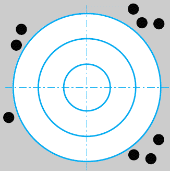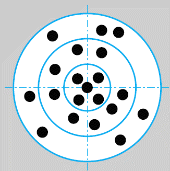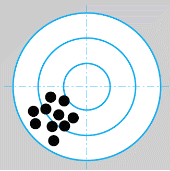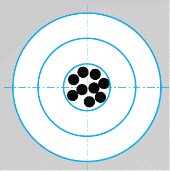The dart board simulates the volume range around the centered specified value, the black dots simulate the different measured values of a specified volume.

Hits far off center.
Hits widely scattered.
These volumetric instruments are of inferior quality.

On average, hits are evenly distributed around center.
No gross errors, but hits widely scattered.
All deviations are "equally probable". Instruments exceeding the permissible limit should be removed from service

Although all hits are close together, the center (true volume) is still missed.
All hits are close together.
Improperly controlled production, with systematic variation. Instruments exceeding the permissible limit should be removed from service.

All hits are near the center, i.e., the specified value.
All hits are close together.
The volumetric instruments have minute systematic errors, narrow scatter; the permissible limit is not exhausted. These instruments should remain in service.
To describe accuracy, the term "Error limit" is used for glass volumetric devices, while for liquid handling devices the statistical terms "Accuracy [%]" and "Coefficient of Variation [%]" have become established.

The term "Error limit" (EL) in the corresponding standards defines the maximum permissible deviation from the specified value.

Accuracy (A) indicates the closeness of measured mean volume to the specified value, i.e., systematic measurement variation. Accuracy is defined as the difference between the measured mean volume (V) and the specified value (Vspec.), related to the specified value in percent.

Coefficient of variation (CV) indicates the closeness of values of repeated measurements, i.e., random measurement variation. Coefficient of variation is defined as standard deviation in percent, related to the mean volume.

Generally A and CV are related to the nominal volume (Vnom.). These values are in % and have to be converted for partial volumes (Vpart.). In contrast, there is no conversion for partial vol-umes, if A and CV are stated in volume units (e.g., ml).